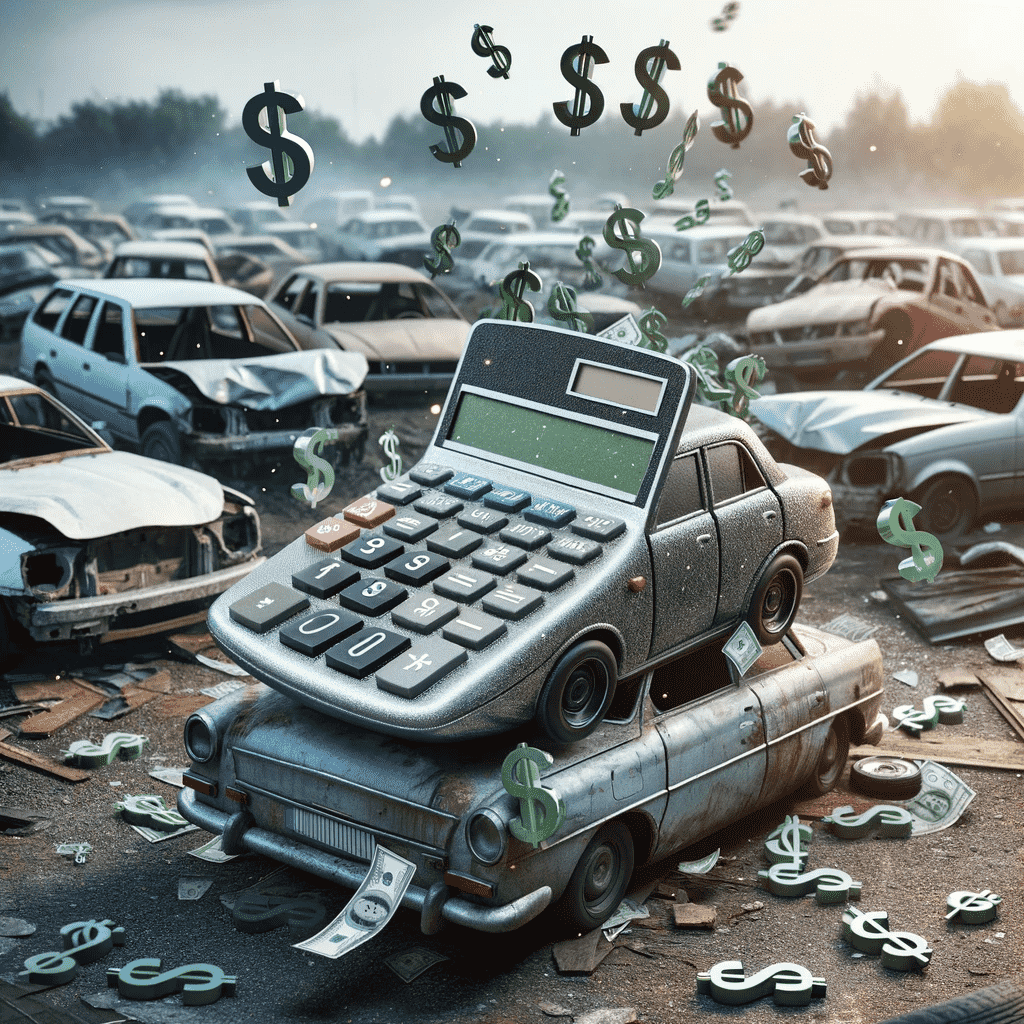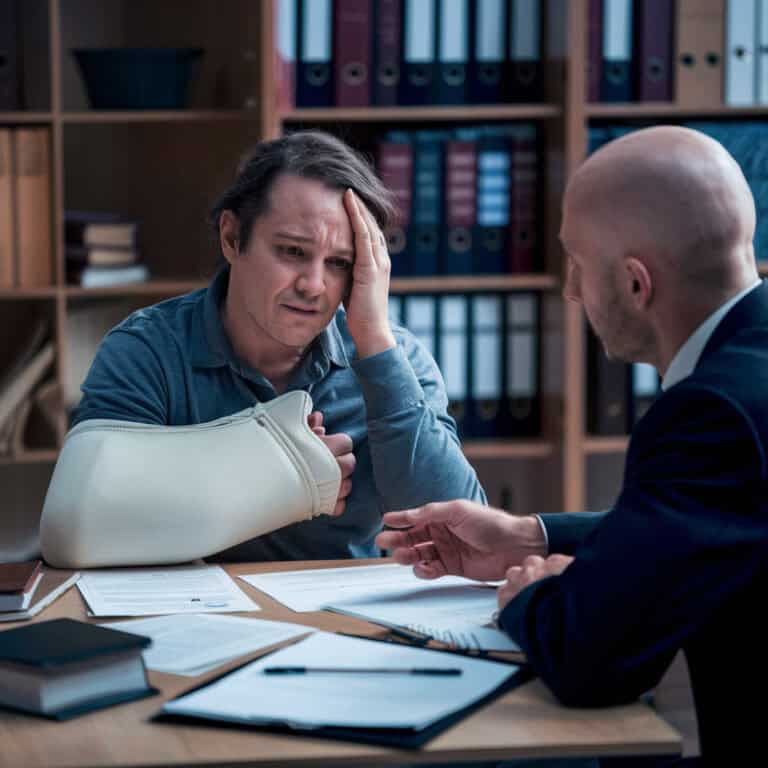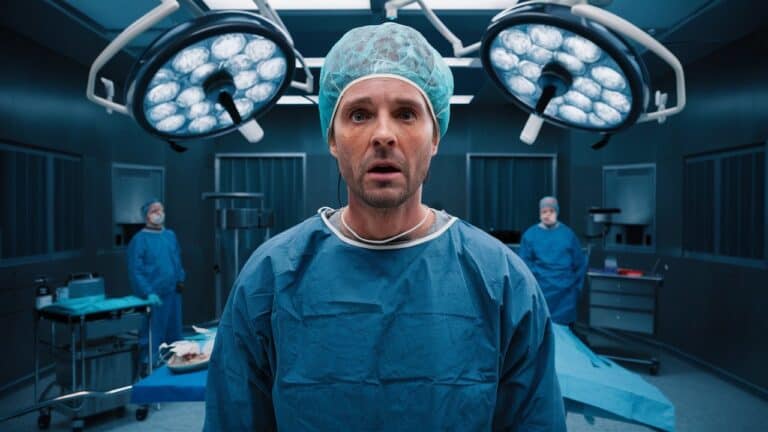Picture this: You’re cruising home after a long day, and out of nowhere, someone sideswipes your car and speeds off. Turns out they were uninsured, leaving you with a dented door and the sinking feeling of having to foot the repair bill. That’s where uninsured motorist property damage comes into play.
In Maryland, safeguarding your vehicle against such scenarios isn’t just smart; it’s required by law. This protection shields you from the headaches that come when an at-fault driver lacks insurance or doesn’t have enough coverage to handle the damages they’ve caused.
You’ll learn about mandatory UMPD in Maryland and why understanding its nuances could save you big time if luck ever turns sour on the road. You will also learn about underinsured motorist coverage and how it is different than uninsured coverage.
Table Of Contents:
- Uninsured Motorist Property Damage Coverage Explained
- The Difference Between UM and UMPD Coverage
- State-Specific Requirements for UMPD in Maryland
- Assessing Your Need for UMPD Coverage
- How to File a Claim for Uninsured Motorist Property Damage in Maryland
- Understanding Policy Limits and Deductibles for UMPD in Maryland
- Comparing Uninsured Motorists’ Impact Across States
- Common Types of Damages Covered Under Your Auto Policy’s UMPD Clause
- Tips for Dealing With Insurers Regarding Claims Involving Uninsured Drivers
- FAQs in Relation to Uninsured Motorist Property Damage
- Conclusion
Uninsured Motorist Property Damage Coverage Explained
If you’ve ever felt the sting of car repairs after an accident with a driver who skipped out on insurance, then you know why uninsured motorist property damage (UMPD) coverage is your financial safety net. This auto insurance policy hero steps in to cover repair costs for your chariot and other belongings when the at-fault party has no insurance.
Think of UMPD as that reliable buddy always ready to pick up the tab when someone else lets you down. It’s not just about getting your car fixed; it’s peace of mind knowing that if an uninsured driver rams into your ride, you won’t be left high and dry with a hefty bill.
In Maryland, where driving without proper coverage isn’t just frowned upon but also against the law, UMPD isn’t optional—it’s mandatory. That means every time Marylanders hit the road, they carry this shield against unpredictable drivers without adequate protection. And while some states might leave UMPD off their must-have list, those rolling through The Old Line State can thank their lucky stars—or lawmakers—for this compulsory cushion.
What Is Uninsured Motorist Property Damage (UMPD) Coverage
Digging deeper into what UMPD covers can save many headaches later on. If another motorist crashes into your vehicle and doesn’t have enough or any insurance cover, guess who gets stuck with repair bills? Without UMPD coverage—surprise—you. But add this nifty clause to your auto insurance plan, and voilà: damages caused by these reckless roadsters get covered up to a certain limit.
This type of protection typically extends beyond just fixing dents or shattered glass; it may also include reimbursement for personal items turned casualties during the crash-and-bash saga inflicted by an insured perpetrator. So next time there’s talk around West Virginia campfires or Vermont maple trees about what happens after deer-car tangoes gone wrong—Maryland residents can confidently say their trusty sidekick UMPD has got them covered.
Hit by an uninsured driver? Don’t sweat the repair costs—UMPD coverage has got your back, paying for damages so you’re not stuck with the bill. In Maryland, it’s a must-have; like a good friend who always covers you when others bail.
The Difference Between UM and UMPD Coverage
When a fender-bender turns into a financial headache because the other guy lacks insurance, that’s where your savvy decision to include both uninsured motorist (UM) coverage and uninsured motorist property damage (UMPD) in your policy pays off. Think of UM as your medical bill buddy—it steps in to cover bodily injury when you’re hit by someone who’s not carrying enough or any car insurance. On the flip side, UMPD is like having a guardian for your car; it takes care of repair costs if an at-fault driver with no insurance decides to redecorate your bumper.
Understanding Your Insurance Plan’s Coverages
Maryland insists on making sure drivers have protection against these scenarios. It joins states like South Carolina, Vermont, Virginia, West Virginia, among others, mandating UMPD coverage—because nobody likes surprise expenses from accidents they didn’t cause.
Diving deeper into the nuts and bolts: while UM covers what happens to you physically up to certain limits defined by your policy, it doesn’t extend its helpful hand towards damages done to your ride or personal belongings—that’s where UMPD comes into play. This coverage ensures that hitting a curb due to swerving away from an irresponsible driver won’t lead you down the path of out-of-pocket despair.
You might think handling deer car damage or getting dinged-up by road debris is covered under standard auto policies but without specific add-ons like UMPD—you could be left wishing upon damaged headlights instead of stars for some monetary relief.
In Maryland—the Free State with not-so-free repairs—law requires insurers provide at least $15,000 per accident in property protection which can help soften blows caused by incidents ranging from rodent havoc inside engines all the way through malicious key scratches etched onto doors—a small price for peace of mind amidst chaos brought forth by those playing fast and loose with liability laws.
Your best bet? Double-check those declarations pages before saying yes—to ensure neither bird poop stains nor pothole mishaps leave wallets lighter than they should be after crossing paths with law-skirting motorists.
State-Specific Requirements for UMPD in Maryland
If you’re cruising through the Old Line State and find yourself on the receiving end of a fender bender with an uninsured driver, you’ll be thankful for your Uninsured Motorist Property Damage (UMPD) coverage. In Maryland, it’s not just recommended; it’s mandated by law to have this safety net as part of your auto insurance policy. This means if another motorist without coverage decides to play bumper cars with your vehicle, UMPD has got your back.
Mandatory vs. Optional UMPD Coverage in Maryland
The Free State stands firm on protecting its drivers against uninsured ones. While some states may give you the option to skip out on this kind of protection, here in Maryland that’s not the case. Every auto policy must include UMPD – no ifs or buts about it. So whether you’re dodging potholes in Baltimore or navigating country roads up north, rest assured that property damage caused by an elusive at-fault driver won’t leave a gaping hole in your wallet.
In comparison to our neighbors who might flip-flop between requiring and offering optional motorist coverage perks like these, we can all agree there’s something comforting about knowing what’s expected right off the bat.
Understanding Your Insurance Plan’s Coverages
Digging into an insurance plan can feel like decoding ancient hieroglyphics—confusing and time-consuming—but getting familiar with yours is crucial. Knowing how UM differs from UMPD could save you a headache down the road: think bodily injury versus bent bumpers and broken mirrors—the former deals with people while latter covers things.
Buckle up because understanding this distinction ensures when life throws a wrench—or rather—an uninsured driver into your path; you’ll navigate smoothly around financial setbacks instead of crashing head-on into them.
Hit by an uninsured driver in Maryland? Don’t sweat it. UMPD coverage is mandatory, so damage to your car won’t wreck your finances.
Diving into insurance details matters—knowing the difference between UM and UMPD could be a financial lifesaver when dealing with accidents and damages.
Assessing Your Need for UMPD Coverage
Deciding on uninsured motorist property damage (UMPD) coverage can feel like trying to predict the weather in Maryland—you never know when you’ll run into a storm. But let’s get real, this isn’t about clouds and rain; it’s about protecting your wallet from the unexpected hit-and-run of an uninsured driver.
When Is UMPD Coverage Necessary?
Say you’re driving through Baltimore and bam. An at-fault driver smashes your tail light and speeds off. Worse yet, they’re one of those drivers without insurance coverage. That’s where UMPD steps in. It covers repair costs for damages like that busted tail light or even more severe car engine flooded issues caused by uninsured motorists—no need to chase down the yellow bird poop stain culprit who damaged your ride.
Factors Influencing Your Insurance Choices
Your auto insurance policy isn’t just another document; it’s a shield against mishaps ranging from deer car damage to hitting a curb too hard because someone thought playing chicken with traffic was fun. In Maryland, having insurance cover for these incidents, including malicious damage or dog scratches on cars, means not having to pay out-of-pocket after such unfortunate events.
The bottom line? Whether it’s a rental car accident during a weekend getaway or finding mysterious cosmetic damage after parking downtown overnight—we’ve all been there—determining if you need UMPD is crucial. Consider how much risk you’re willing to take versus peace of mind knowing that no matter what type of property damage befalls your four-wheeled friend—from bird poop stains on paint jobs to broken mirrors—a safety net exists thanks largely due to comprehensive protection offered by insurers in cases involving those pesky underinsured motorists.
How to File a Claim for Uninsured Motorist Property Damage in Maryland
Initiating Your Insurance Claim
Filing a claim when you’re hit by an uninsured driver in Maryland doesn’t have to be like navigating through a maze blindfolded. It’s not just for personal injury. First, check your insurance policy—you’ll want to make sure it includes uninsured motorist property damage coverage, which is thankfully required by law here. Once confirmed, promptly notify your insurer about the incident; they need the who, what, where and when.
Your next step? Gather evidence from the scene of the accident. Think Sherlock Holmes—photos of damages, witness statements—if there’s bird poop on your car from that ill-timed drive under a tree during investigation—it counts too. Then jot down notes about how everything went down before details start getting foggy.
Contacting local authorities can also add official oomph to your claim if you’ve got a police report detailing things like deer dents or malicious mischief caused by some rascal kicking up rocks at your ride.
Documentation Needed for a Successful Claim
To get back on track faster than lightning without losing out financially requires proof—and lots of it. We’re talking repair estimates (yes plural) for car damages, receipts for any immediate fixes needed just so you could limp home after hitting that monster pothole or curb—or even rental costs while waiting for repairs because someone decided their text was more important than watching the road.
And don’t forget documentation showing ownership and value—a must-have if we’re going into diminished value claims post-accident with an at-fault driver missing adequate coverage or any semblance of responsibility really.
Last but not least: patience and persistence are key when dealing with insurers after accidents involving uninsured drivers. Automobile Insurance. Stick close to these steps and remember: In Maryland, as long as lady luck isn’t completely against you—that yellow bird stain included—you’ve got legal backing ensuring protection against those rogue motorists roaming free without insurance cover.
Hit by an uninsured driver in Maryland? Make sure your policy includes coverage, snap evidence photos, and get a police report to strengthen your claim. Collect repair estimates and prove car value—patience pays off when seeking what you’re owed.
Understanding Policy Limits and Deductibles for UMPD in Maryland
Ever felt like you’re playing a high-stakes game of dodgeball, but instead of balls, it’s uninsured drivers? Well, that’s where Uninsured Motorist Property Damage (UMPD) coverage comes into play. It’s the shield that helps protect your wallet from getting hit when an at-fault driver lacks insurance.
Deciphering Your Policy’s Fine Print
Digging into your auto insurance policy to understand UMPD can be as exciting as watching paint dry, but stick with me—it could save you some serious cash. Coverage limits are not just numbers pulled out of thin air; they’re carefully calculated figures based on potential risks and costs. In Maryland, these limits may vary widely because every car owner has different needs. But remember this: if damages exceed your limit after an accident with an uninsured motorist in Baltimore or Parkville—or anywhere else—you might have to pay out-of-pocket for the difference.
Deductibles also come into play before benefits kick in—think of them as the entry fee to claim your coverage prize. They often start around $250 but can go higher depending on how bulletproof you want your financial protection to be against property damage caused by rogue motorists without a shred of insurance cover.
The takeaway here isn’t about fear—it’s about preparation. So whether it’s deer car damage in Laurel or hitting a pothole hard enough to make both coffee cups fly off Ellicott City dashboards—having robust UMPD coverage ensures peace of mind faster than saying “insurance company hotline.” To get more insight on navigating through various policies’ maze-like terms,click here.
Playing dodgeball with uninsured drivers? UMPD is your financial shield. Know your policy’s limits and deductible in Maryland—don’t get caught paying the difference for damages.
Dry as it might be, understanding your UMPD can save you cash. A low deductible means less out-of-pocket after a mishap with an uninsured driver; make sure you’re covered.
It’s not about fear, but preparation. With solid UMPD coverage, hit those potholes or deer without worry—peace of mind comes standard.
Comparing Uninsured Motorists’ Impact Across States
Lessons from States with Mandatory UMPD Laws
The tale of uninsured motorists is as varied as the states they drive in. Some places like Maryland make sure you’re covered, mandating uninsured motorist property damage (UMPD) coverage. This isn’t just a feel-good policy—it’s your financial shield against that ‘what-if’ scenario where an uninsured driver smashes into your car.
In our tour across state lines, we see different strokes for different folks. While some states might shrug off mandatory UMPD laws, others stand firm. The stats don’t lie; these mandates do shake things up—shifting the needle on uninsured drivers’ rates.
If you find yourself cruising through Vermont or West Virginia, breathe easy knowing they’re in your corner too. They’ve joined Maryland’s ranks by requiring all drivers to have this protection baked into their auto policies.
Varying Degrees of Success in Reducing Rates of Uninsured Drivers Across States
You’ve got to wonder if it’s luck or law that keeps some states ahead in this game. Take South Carolina and North Carolina—they boast numbers showing fewer ghost cars without insurance haunting their roads thanks to strict legislation compared to those rolling the dice out west.
Mandatory coverage? It works wonders—but it’s not a silver bullet everywhere you look because there are always outliers slipping through cracks wider than potholes on I-95.
But let me tell you something curious about good ol’ yellow bird poop stain incidents—if someone’s ride gets dinged by one while parked at home and no culprit steps forward, guess what saves the day? Yep, UMPD kicks in here too.
We could say each state dances to its own tune when facing down uninsured troublemakers behind wheels—or lack thereof—and whether its moves keep them off streets seems partly written by rulebooks but also etched by other mysterious factors only roadside diners whisper about over coffee refills and pie slices…
Some states like Maryland got your back, making sure you’re covered with mandatory UMPD coverage—it’s a financial lifesaver against uninsured drivers.
Different states take their own paths, but the proof is in the pudding: where UMPD laws are strict, there tend to be fewer uninsured drivers out and about.
UMPD isn’t just for crashes—hit-and-run damage while parked? It’s got you covered. Every state has its rhythm in dealing with uninsured drivers; it’s part law, part mystery.
Common Types of Damages Covered Under Your Auto Policy’s UMPD Clause
That’s where uninsured motorist property damage (UMPD) coverage comes into play.
Home or Residential Property Damages
The first thing to understand is that UMPD isn’t just about your car; it can also cover home damages. Picture this: An uninsured driver loses control and takes out part of your fence. With UMPD, those repairs won’t come straight from your pocket if an at-fault driver has no insurance cover.
But let’s get real—how often does a rogue vehicle end up in someone’s living room? It might seem like something out of a movie scene, but it happens more than you’d think. So make sure when picking an auto policy, consider one that gives peace of mind for both on and off-road mishaps.
Vehicle Repair Costs After an Accident With an Uninsured Driver
Moving onto the star player—the beloved automobile. When another motorist causes damage to your ride without having their own insurance coverage squared away, UMPD steps up to bat for things like cosmetic damage car repairs or even major issues such as engine damage from overheating after getting rear-ended by said uninsured culprit.
We’re talking covering costs ranging from fixing bird poop stain on car paint (which believe it or not can be seriously expensive), all the way through repairing serious collision damages like those incurred in accidents involving rental cars—a nightmare scenario whether it’s yours or a rental company’s vehicle. And should calamity strike in the form of hitting a pothole hard enough to warrant new suspension parts? Yep, covered too.
In Maryland alone—land known for its blue crabs and unpredictable traffic alike—it’s mandated by law that drivers have some level of protection against these unfortunate events through policies including UM clauses tailored specifically towards property damage caused by our ghostly non-insured friends behind wheels.
Don’t let an uninsured driver’s mistake hit your wallet—UMPD covers more than just car dents, from home repairs to major vehicle fixes. Get the coverage that keeps you calm in Maryland’s chaotic traffic.
Tips for Dealing With Insurers Regarding Claims Involving Uninsured Drivers
When you’re hit by an uninsured driver, the headache of car repairs is just the start. But with a cool head and smart tactics, navigating your claim can be smoother than you think.
Negotiating With Insurers Post-Accident
The moments after an accident are critical. First things first: make sure everyone’s okay; then get to work. Snap pictures of the damage and exchange info if possible—even without insurance details from them, it matters for your records.
Your policy might include uninsured motorist coverage, which acts as a financial safety net when someone without insurance leaves their mark on your vehicle—or worse yet—causes bodily harm to you or passengers. Remember though, dealing with insurers means knowing what’s covered under that safety net so read up or chat with an agent about how uninsured motorist property damage plays into it all.
Documentation Best Practices
Gather evidence like it’s gold dust—it kind of is in insurance claims. Police reports? Get them. Photos? Click away. Eyewitness accounts? Yes please.
Detail every scratch and dent when filing—that’s where documenting specifics pays off big time—and keep track of repair estimates too since they add weight to your argument against stingy payouts from insurers over damages caused by at-fault drivers who skimped out on their own policies.
If negotiations feel more intense than arm-wrestling contests remember—you’ve got rights as well as responsibilities here. Communicating effectively with insurers takes patience but also persistence; so hold firm on getting what’s fair considering everything you’ve paid into those premiums month after month.
Hit by an uninsured driver? Keep calm and collect evidence—photos, police reports, witness statements. This is key to a strong claim. Reach out to your insurer pronto and know what your policy covers for uninsured motorist property damage.
Gathering detailed documentation boosts your chance of a fair settlement from insurers when the other driver has no insurance. Stand firm in negotiations; remember you have rights too.
FAQs in Relation to Uninsured Motorist Property Damage
How does uninsured motorist insurance work in Maryland?
In Maryland, it kicks in when the at-fault driver can’t pay for your losses. It covers car repairs and sometimes more.
What is the disadvantage of uninsured motorist coverage?
The downside? It may not cover all costs, leaving you to foot part of the bill.
What is the difference between collision and uninsured motorist insurance?
Collision pays for your car’s damages after a crash. Uninsured motorist steps up if the other guy isn’t insured.
What is UMPD coverage in California?
In California, UMPD covers vehicle damage from an accident with an uninsured driver—up to policy limits, that is.
Conclusion
So, you now know the drill. Protecting your ride in Maryland means getting uninsured motorist property damage coverage. It’s not just wise; it’s the law.
You’ve seen how UMPD keeps you covered when others fall short. You understand that while UM handles injuries, UMPD takes care of your car.
State laws vary but remember this: Maryland has got your back with mandatory protection against those hit-and-run headaches and underinsured mishaps.
Digging deeper could mean adding extra layers to that safety net—think about whether more coverage is right for you.
And if ever facing down damages from an uninsured driver? Keep calm and claim on—you’re prepped to handle it like a pro.





